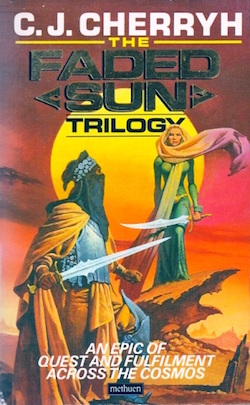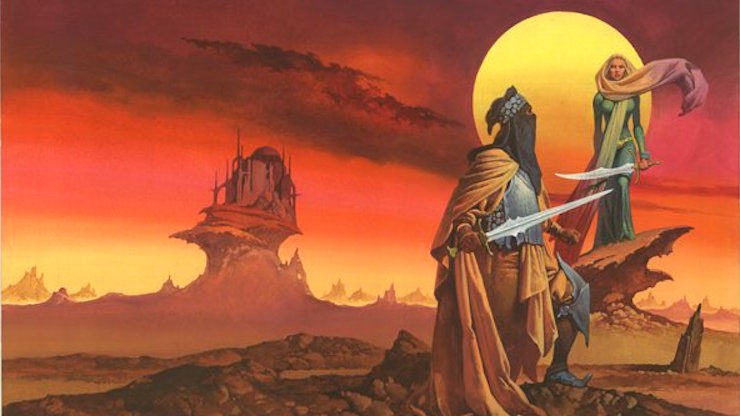Every year or two, someone writes another article about a genre that women have just now entered, which used to be the province of male writers. Usually it’s some form of science fiction. Lately it’s been fantasy, especially epic fantasy (which strikes me with fierce irony, because I remember when fantasy was pink and squishy and comfy and for girls). And in keeping with this week’s theme, space opera gets its regular turn in the barrel.
Women have always written space opera.
Ever heard of Leigh Brackett? C.L. Moore? Andre Norton, surely?
So why doesn’t everyone remember them?
Because that second X chromosome carries magical powers of invisibility. Women writers don’t get the reviews. Don’t get the promo. Don’t get the Serious Critical Attention. They’re ignored or dismissed as “not important.” They are, in a word, erased. X’ed out. Forgotten.
Remember Ardath Mayhar? Sheri Tepper? Elizabeth Moon, maybe? C.J. Cherryh, even?
But! the Very Serious People cry. We have women on our list! Look! Ursula K. Le Guin! Lois McMaster Bujold! Ann Leckie!
Very fine writers, those. Wonderful books. I love them. But here’s the thing.
It’s called the Smurfette Principle. In my head, which lives and dies by mashups, it’s like Highlander, but in shades of blue. There Can Be Only One.
The universe is entirely male. Everything is defined by that gender. Male is default. One female is allowed to exist. She is, by her existence, presumed to contain her entire gender. She’s there, she’s complete. No other female need apply.
This is so prevalent that even female writers will front-load their universes with males—I’ve been rereading Andre Norton right here at Tor.com, and she consistently defaults to male protagonists and male-dominated adventures. Her females are deliberately strong and subversive, but in speaking roles, they’re in the distinct minority. They’re also, almost without exception, not standard human women. Mostly they’re aliens. Maelen. Jaelithe. Half-Earthling, all-inept Kaththea. It’s a man’s universe, and women have to be downright alien to be seen or heard.
It doesn’t stop. When I was watching Rogue One, sure enough. Female protagonist, yay! But…where are the rest of the women? The crew of merry men are all, well, men. A couple of female pilots sneak in under the radar, but if they’re representative of the proportion of women to men in the Star Wars universe, there’s definitely a problem with the continuation of the species.
It never even occurred to the men writing and directing this film that they might even out the gender balance. They just went ahead and did what they always do. Even when they think they’re being feminist and edgy and liberated and all that good stuff. They gave us another Smurfette. She’s a great Smurfette, but she still reads blue.
That’s what happens with women writers. In each generation, one is chosen to be named on all the lists and cited by all the Serious People. Once she’s selected, the Serious People dust off their hands and say, “There. We have a female. That’s sorted.” And go right back to focusing on male writers and ignoring the rest of the females.
In recent years there’s been pushback so strong, and cultural shifts so compelling, that we’re finally seeing all or predominantly female major award lists, and recognition that half the species is, indeed, not-male (and that’s not even getting into gender-fluidity and non-binary persons). That’s an amazing development, and I hope a permanent one. But it still erases the women who came before.
As a species, we are mri.
 Mri are the alien protagonists of C.J. Cherryh’s Faded Sun trilogy (DAW, 1978-9): The Faded Sun: Kesrith, The Faded Sun: Shon’jir, and The Faded Sun: Kutath. They’re interstellar mercenaries in black with swords, fierce, deadly, and nearly extinct, and their culture is powerfully matriarchal. As the story unfolds, we discover that this is but the latest of countless near-genocides of the species. Over and over, their employers have ended their wars and destroyed the warriors, driving the remnants out into the wastes of space.
Mri are the alien protagonists of C.J. Cherryh’s Faded Sun trilogy (DAW, 1978-9): The Faded Sun: Kesrith, The Faded Sun: Shon’jir, and The Faded Sun: Kutath. They’re interstellar mercenaries in black with swords, fierce, deadly, and nearly extinct, and their culture is powerfully matriarchal. As the story unfolds, we discover that this is but the latest of countless near-genocides of the species. Over and over, their employers have ended their wars and destroyed the warriors, driving the remnants out into the wastes of space.
And every time, the mri have consciously forgotten everything that went before, except for a gnomic verse. Here’s the first half of it:
From Dark beginning
To Dark at ending
Between them a Sun
But after comes Dark,
And in that Dark,
One ending.
The mri’s entire existence has become a process of forgetting. With each new incarnation and each new war, they remake themselves, then escape again into oblivion. The trilogy is about unwinding the Dark and finding their way back home on a long trail of blasted planets, till they finally reach the homeworld.
That’s women’s writing. Remembering anything written by a woman that is more than ten or twenty years old requires a conscious effort and a fair amount of digging and exhuming—unless of course she’s the Smurfette of her generation; then she’s the one holy she’pan who may remain in the collective memory.
It’s interesting to me that the creator of this rather striking (and perhaps inadvertent) analogy is a woman writing from behind initials—as women have tended to do, to slip under the radar of Those Who Will Not Read Books By Girls—and herself not nearly as well known as she was thirty years ago. She’s also another example of the woman writer whose representative of the human species is male; the strong and compelling female character, as usual, is alien.
Have we finally reached the homeworld? Maybe, for the current crop of women writers. But there are decades of blasted planets and long stretches of Dark behind them.
Here’s a place for remembrance. What are your favorite space operas written by women who are not Le Guin or Bujold or Leckie? Maybe if we all share, we’ll rescue a few more names from the Dark, and bring them home.
Top image: The Faded Sun Trilogy cover art by Gino D’Achille; Methuen Publishing, 1987.
Judith Tarr’s first novel, The Isle of Glass, appeared in 1985. Her first space opera, Forgotten Suns, was published by Book View Café in 2015; a sequel is in the works. She’s written historicals and historical fantasies and epic fantasies, some of which have been reborn as ebooks from Book View Café. She has won the Crawford Award, and been a finalist for the World Fantasy Award and the Locus Award. She lives in Arizona with an assortment of cats, a blue-eyed spirit dog, and a herd of Lipizzan horses.










